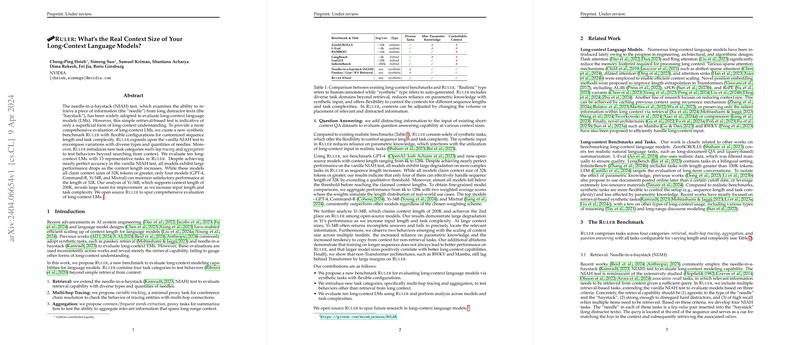Expanding Long-Context Evaluation: Introducing Ruler for Comprehensive LLM Analysis
Overview of Ruler Benchmark
Researchers have developed Ruler, a synthetic benchmark designed for a comprehensive evaluation of long-context LLMs (LMs). Ruler advances beyond the traditional needle-in-a-haystack (NIAH) test by encompassing a wider range of tasks that evaluate not only retrieval capabilities but also multi-hop tracing, aggregation, and question answering within extended contexts. This benchmark is tailored to dissect long-context LMs' behaviors in scenarios that demand nuanced understanding and manipulation of context, addressing a gap in existing evaluation methodologies.
Task Categories in Ruler
Ruler is comprised of tasks grouped into four categories, each designed to probe different aspects of long-context LMs:
- Retrieval: Beyond the standard NIAH test, this category assesses models' abilities to retrieve information under various complexities, including the presence of distractors and the requirement to recall multiple related items.
- Multi-hop Tracing: Introducing tasks like variable tracking to evaluate models on their capacity to manage coreference chains and entity tracking over extended texts.
- Aggregation: Through tasks such as common and frequent words extraction, this domain probes models' abilities to synthesize and summarize information from large swaths of text.
- Question Answering: By inserting distracting information into input from existing short-context QA datasets, this category examines how well models can extract relevant answers from lengthy contexts.
Evaluation and Insights
The evaluation encompassed ten prominent long-context LMs across Ruler's 13 representative tasks. Results highlighted a notable performance degradation in more complex tasks as context length increased, even among models boasting context sizes greater than 32K tokens. Only a subset of models maintained robust performance at such lengths, with notable names including GPT-4, Command-R, Yi-34B, and Mixtral.
A detailed examination of Yi-34B, which claims a context length of 200K, underscored substantial opportunities for improvement, particularly in complex and prolonged input scenarios. This analysis revealed trends such as increased reliance on parametric knowledge and a propensity for models to directly copy content from context in non-retrieval tasks, underlining the crucial areas for future enhancements in long-context modeling.
Theoretical and Practical Implications
Ruler's introduction and the findings from its application underscore the evolutionary trajectory of long-context understanding in LMs. The nuanced testing framework it proposes moves beyond mere retrieval, opening avenues for exploring how LMs assimilate, recall, and synthesize information across expansive texts. The benchmark’s synthetic nature affords crucial advantages, including reduced dependence on pre-existing knowledge and enhanced control over task complexity.
Future Directions in AI
The insights gleaned from Ruler point towards several future directions. One immediate area is the optimization of models for enhanced performance across the new benchmark's tasks, particularly focusing on weaknesses in aggregation and multi-hop tracing capabilities. Additionally, the demonstrated need for models to efficiently manage longer contexts without resorting to copying suggests an avenue for architectural innovations. Finally, the exploration of non-Transformer architectures within this rigorous testing framework highlights the potential for diverse model designs to enhance long-context performance.
Ruler is open-sourced, encouraging further experimentation and adaptation. Its creation marks a significant step towards a more holistic understanding of long-context capabilities in LMs, promising to guide the next wave of advancements in generative AI.
